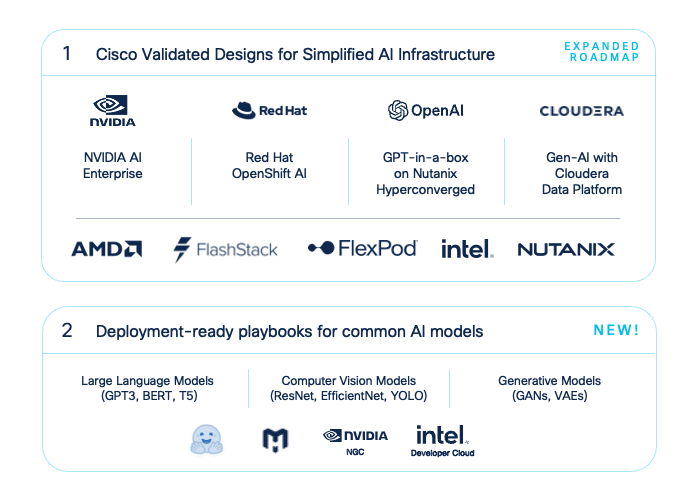The hype triggered by the emergence of generative artificial intelligence (AI) feels a lot like the early days of cloud, bringing the topic—and the need for a strategy—to the front of the IT leader agenda.
But while AI is poised to change every aspect of our lives, the complexity of AI infrastructure and operations is holding things back. At Cisco, we believe AI can be a lot easier when we find ways to avoid creating islands of operations and bring these workloads into the mainstream.
AI is driving big changes in data center technology
AI workloads place new demands on networks, storage, and computing. Networks need to handle masses of data in motion to fuel model training and tuning. Storage needs to scale effortlessly and be closely coupled with compute. Plus, computing needs to be accelerated in an efficient way because AI is seeping into every application.
Consider video conferencing. In addition to the familiar CPU-powered elements like chat, screen sharing, and recording, we now see GPU-accelerated components like AI inference for real-time transcription and generative AI for meeting minutes and actions. It’s now a mixed workload. More broadly, the demands of data ingest and preparation, model training, tuning, and inference all require different intensities of GPU acceleration.
Using proven architectures for operational simplicity
IT teams are being asked to stand up and harden new infrastructure for AI, but they do not need new islands of operations and infrastructure or the complexity that comes with them. Customers with long-standing operating models built on solutions like FlexPod and FlashStack can bring AI workloads into that same domain of simplicity, scalability, security, and control.
The constituent technologies in these solutions are ideal for the task:
- UCS X-Series Modular System with X-Fabric technology allows for flexible CPU/GPU ratios and cloud-based management for computing distributed anywhere across core and edge.
- The Cisco AI/ML enterprise networking blueprint shows how Cisco Nexus delivers the high performance, throughput, and lossless fabrics needed for AI/ML workloads; we believe Ethernet makes the ideal technology for AI/ML networking due to its inherent cost-efficiency, scalability, and programmability.
- High-performance storage systems from our partners at NetApp and Pure complete these solutions with the scalability and efficiency that large, growing data sets demand.
Introducing new validated designs and automation playbooks for common AI models and platforms
We’re working hard with our ecosystem partners to pave a path for customers to mainstream AI. I’m pleased to announce an expanded road map of Cisco Validated Solutions on proven industry platforms, along with new automation playbooks for common AI models.
These solutions span virtualized and containerized environments, multiple converged and hyperconverged infrastructure options, and important platforms like NVIDIA AI Enterprise (NVAIE).
These solution frameworks rely on our three-part approach:
- Mainstreaming AI infrastructure to reduce complexity across core, cloud, and edge.
- Operationalizing and automating AI deployments and life cycle with validated designs and automation playbooks.
- Future-proofing for emerging component technologies and securing AI infrastructure with proactive, automated resiliency, and in-depth security.
“Building on a decade of collaboration, Cisco and Red Hat are working together to help organizations realize the value of AI through improved operational efficiencies, increased productivity and faster time to market. Cisco’s AI-focused Cisco Validated Design can help simplify, accelerate and scale AI deployments using Red Hat OpenShift AI to provide data scientists with the ability to quickly develop, test and deploy models across the hybrid cloud.”
—Steven Huels, General Manager, Artificial Intelligence Business, Red Hat.
The momentum is real; let’s build for the future
AI’s infusion into every industry and application will continue to accelerate, even as the component technologies each make their way through the hype cycle to adoption. Increased data collection and computing power, advancements in AI frameworks and tooling, and the generative AI revolution—are all fueling change. Let us help you build on trusted architectures and take these workloads mainstream for maximum effect.
Join our December 5 webinar:
It’s Time to Simplify AI Infrastructure and Operations

CONNECT WITH US